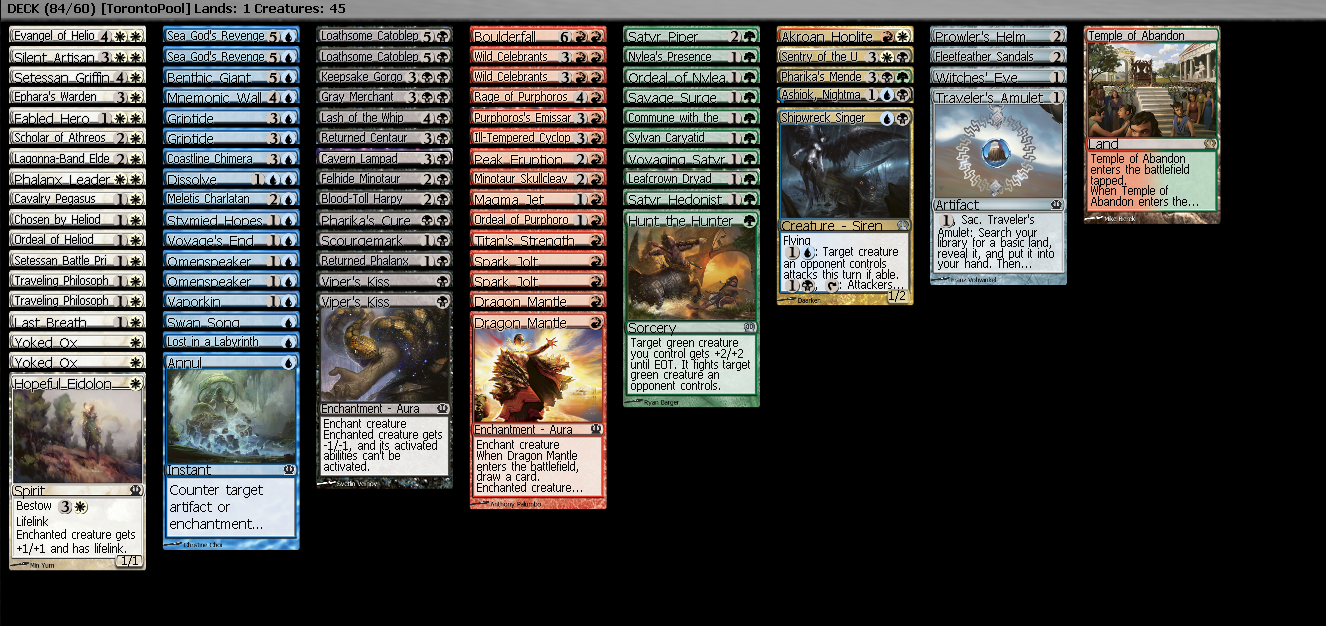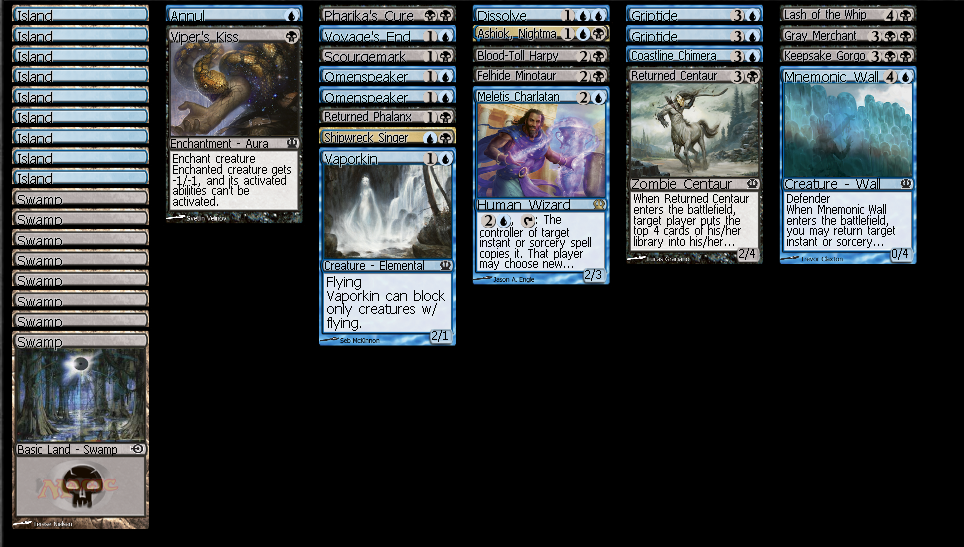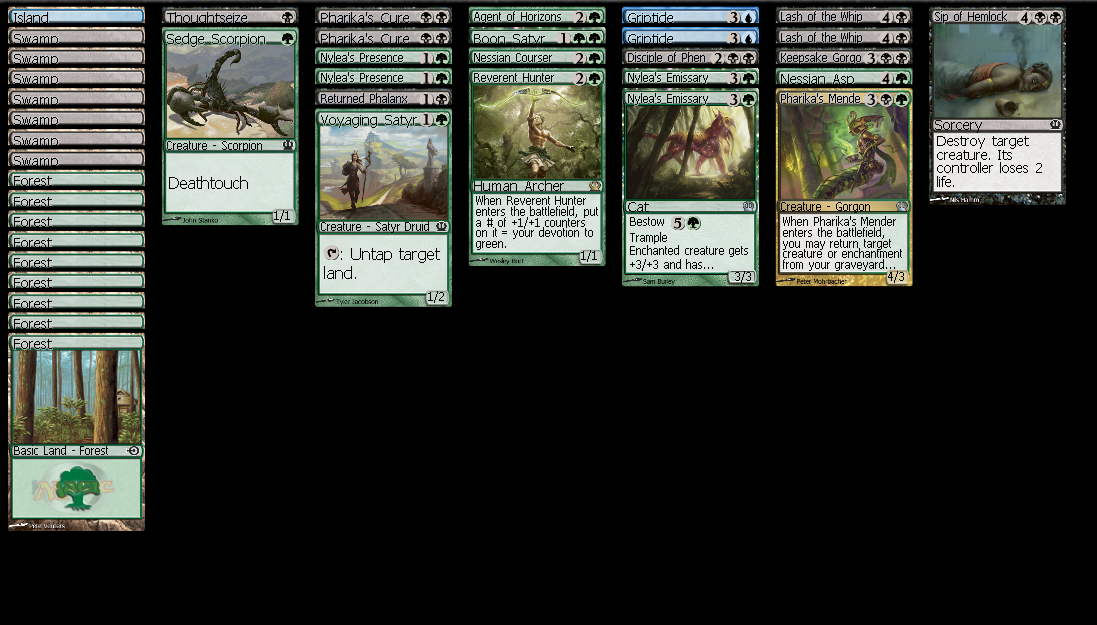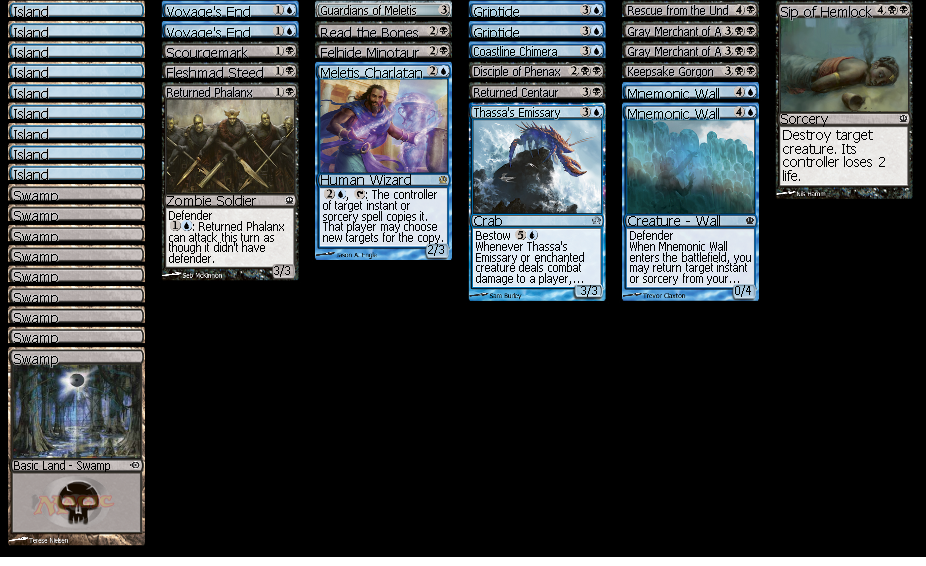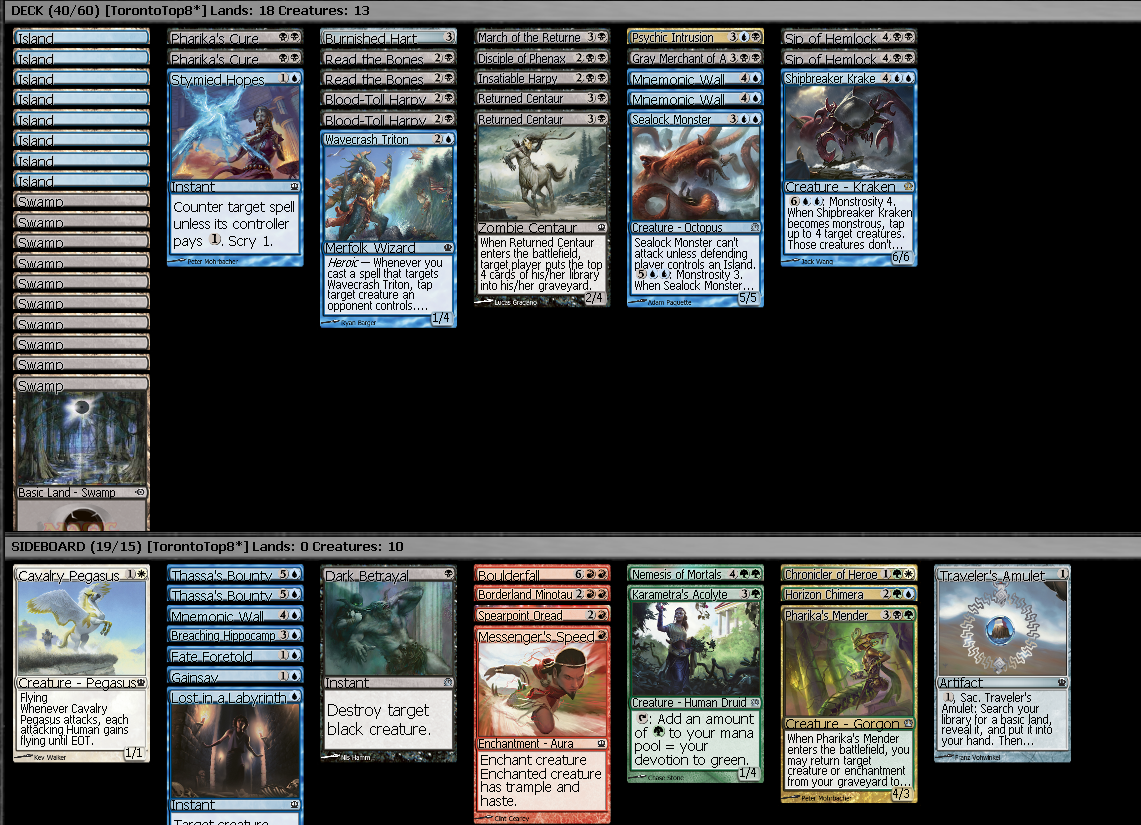Top 8, eh?
After playing Constructed tournaments for what feels like the past ten weekends, I was very happy to be heading to Toronto this past weekend to play some Limited. Because I’d been playing so much Constructed, I hadn’t been playing as much Limited as I would’ve liked, but I’d have a week to prepare. Thanksgiving would cause me to miss a day of practice due to turkey coma, but I should still have plenty of time. Over the course of the week, I spent a lot of time skyping drafts and discussing Sealed builds with friends and teammates. By the time I headed off to Toronto, I was very confident in my abilities in Theros Limited.
I arrived in Toronto and headed to the site to register, and then I was off to Casa de Hoaen, where I’d be staying for the weekend. After a good night’s sleep, we headed to the site. We had to go a little early because Rich only had two byes, but that was okay. I was just going to build with the two-bye sleep-in special crew and practice with my Sealed deck for an hour. Well, when we arrived, the initial deck construction was still in progress. I decided to just build my deck at the one-bye sleep-in special and then go get some lunch. The tournament was obviously going to run late, so being able to get a decent meal was important.
Here is the Sealed pool that I received:
I felt comfortable playing whatever the Sealed gods presented me with, but I was still hoping that my pool lent itself to a U/B Control deck. My hopes were answered, as I opened a mythic rare in Ashiok, Nightmare Weaver and a mythic uncommon in Shipwreck Singer. I’m half joking of course. Shipwreck Singer is not nearly as good as Ashiok, but it’s extremely powerful and one of my favorite cards in Theros Limited.
The first deck I built was U/B Control, and I really liked it. It had everything I was looking for: bombs in Ashiok and Keepsake Gorgon; a really solid early game with Returned Phalanx and two Omenspeakers; and a decent removal package with Lash of the Whip, Pharika’s Cure, and two Griptides (in addition to the Gorgon).
I took note of the two copies of Sea God’s Revenge and looked to see if there was a good aggressive deck that I could fit those into. Green was extremely shallow and not very powerful, so I quickly eliminated that. I laid out U/W, but the blue cards weren’t very aggressive themselves and didn’t complement the white very well aside from the Sea God’s Revenges.
W/R was actually a decent deck, with Phalanx Leader, Fabled Hero, and some good heroic enablers. It also had a bunch of aggressive two-mana creatures like Akroan Hoplite and two Traveling Philosophers. I laid this deck out, and while the bulk of it was good, it was only eighteen or nineteen cards deep. Because I’d have too much filler, the red really wasn’t that powerful, and I really liked the U/B deck so I didn’t consider this deck too deeply.
Here is the U/B deck I submitted:
The meat of the deck is pretty good. Of the last few cards, none are cards I would consider to be auto includes. Rather than break down a match with this deck, I’m going to give you a breakdown of individual cards, how they performed for me, and in cases where it might not be obvious why I chose to include them.
Annul: Annul is a pretty good one of for this kind of deck in Theros Sealed. Most decks have a few enchantments, oftentimes just common creatures with bestow or the very powerful uncommon Emissary cycle. Also at rare are the five legendary weapons. The weapons are extremely powerful and very difficult for a U/B deck to beat. Given that Annul is rarely dead in the format and has the potential to deal with a large number of bombs that you’re likely to see as your record gets better and better in a Sealed tournament, I was happy to include it.
Viper’s Kiss: Viper’s Kiss is a mediocre but reasonable card. While I don’t go out of my way to put it into my deck, it’s certainly playable. Obviously it can be used to kill an early one-toughness creature, but it’s also sometimes useful to put on a monstrous creature to prevent the opponent from making their creature gigantic. It also gains a slight bit of value because it is a black permanent for Gray Merchant of Asphodel.
Omenspeaker, Felhide Minotaur, Coastline Chimera, Felhide Minotaur, Returned Phalanx: All reasonable defensive creatures that can keep the board under control while we draw to our win conditions.
Keepsake Gorgon: This card is a bomb. It holds the ground, and for seven mana it can deal with your opponent’s best threat. Not much explanation needed.
Shipwreck Singer: As I said before, I love this card. Singer won me several games. If not removed, given the number of high-toughness creatures the deck has the opponent is often forced to send several creatures to their demise. You can also force your opponent to make very poor trades and eat all their one-toughness creatures in one shot. In combination with a deathtouch creature, like Keepsake Gorgon in this case, the game is just over.
Lash of the Whip, Pharika’s Cure: Quality removal spells. Enough said.
Voyage’s End, Griptide: Both of these are exceptionally good tempo cards, which are especially good in Theros Limited because so many decks use the strategy of creating a giant monster and trying to go the distance with it.
Dissolve: I value countermagic in Limited more highly than most people. I especially like it in Sealed because it can deal with bombs like I explained before with Annul. Dissolve is obviously much more versatile and can be a savior in games where you are able to hold it for something like Elspeth, Sun’s Champion or Hythonia the Cruel, which you have no other way to deal with.
Mnemonic Wall: I really like this card as a source of card advantage. The 0/4 body is a reasonable blocker, and the ability to return your best bounce spell, removal spell, or Dissolve is huge.
Meletis Charlatan: Meletis Charlatan is reasonable even as just a 2/3 for 2U. This card has really impressed me though. The ability to fork a spell for 2U comes into play quite a bit considering how many long games the U/B Control deck can play. Cheap spells like Pharika’s Cure and Voyage’s End are specifically potent in combination with the Charlatan. Late game the ability to copy a spell like Griptide is truly ridiculous, and it’s very hard to lose when you pull it off.
After deck construction, I joked with friends that my goal for the day was to lock someone when I was in a super long game by combining the Charlatan with Griptide and Mnemonic Wall to put the Wall and one of my opponent’s creatures on top of our respective decks every turn while attacking for a small amount of damage. Unfortunately this never happened, but the card was still great for me all day long.
Gray Merchant of Asphodel: Yes, please.
Blood-Toll Harpy, Vaporkin: Neither of these cards is particularly good in U/B Control in general. I do like the ability to be able to nickel and dime for some damage here and there and maybe win with Gray Merchant or Gray Merchant + Voyage’s End to cast it again. Vaporkin is a patricianly aggressive card, so it might seem more out of place here. Ultimately it’s not a card that I generally want in my control decks, but I just felt that it was better than my other options.
Scourgemark: Not a very effective card, but it cycles. It would be considerably worse if I didn’t have so many cheap creatures, thus allowing me to cycle it on the early turns and not be stranded in my hand for too long.
Ashiok, Nightmare Weaver: It comes as no surprise that this was a great card. When I built my deck, I expected to win a lot of games with it. But I definitely didn’t appreciate how truly dominant the card would be. On two different occasions I played games in which I cast Ashiok on turn 3, never dealt or was dealt a single damage, and had my opponent concede five or six turns later. Once I was able to use Ashiok to put an opponent’s Sedge Scorpion into play and force a trade with his 10/10 Nemesis of Mortals by making it attack with Shipwreck Singer. In that same game, I was able to use Ashiok to put my opponent’s Gray Merchant into play to finish him off. Ashiok was easily the best card in my deck.
The most notable cards I chose not to include were two copies of Sea God’s Revenge. In aggressive decks it’s a great card of course, as you can often just win the game when you cast it, but that usually doesn’t hold true in control decks. When you’re winning you don’t usually need it, and when you’re losing it usually doesn’t help that much. It can sometimes buy you a turn or two, but it’s very expensive. Plus I already had two Griptides and a Voyage’s End to work tempo tricks against heroic and monstrous creatures.
There is certainly an argument for including one over the Vaporkin, which I thought about for a long time. Ultimately I went with the Vaporkin, and given that I only sideboarded in one copy of Sea God’s Revenge all day (where I drew it and it essentially ended up doing nothing), I am happy that I made that decision.
I ended up going 8-1 in the Sealed portion, which I was very happy with since it put me into a very good position going into Draft.
On the second day, my first draft started well. After one pack I had something like Nessian Asp, Nessian Courser, Nylea’s Presence, Griptide, Lash of the Whip, Sip of Hemlock, Pharika’s Cure, and Nylea’s Emissary.
This is where things got interesting. In pack 2 I opened Elspeth, Sun’s Champion. Normally Elspeth is such a powerful card that I’d just go ahead and take it. The problem this time was that there was also a Keepsake Gorgon in the pack. I have no problem drafting a Four- or Five-Color Green deck, and if I had Elspeth, I could more aggressively take white cards, Nylea’s Presence, and Traveler’s Amulet.
However, Keepsake Gorgon is a great card too. Clearly it’s not "Elspeth good," but I already had three other good black cards. And even if I’m able to make the white splash easy, a lot of the premium white cards tend to veer on the aggressive side and aren’t what I’m really looking for in my B/G-based decks. Lastly, I didn’t see a lot of white in pack 1 and didn’t expect to see a lot in pack 3. For all these reasons, I decided to choose Keepsake Gorgon.
Here is the deck I ended up with:
Round 10 (9-1) vs. David Ledvinka
David was seated to my right in the draft, which meant that I would very likely be playing against the Elspeth that I decided to pass. David was playing a good W/G deck.
In game 1 I felt I was ahead with a Nessian Asp, Nessian Courser, and a 5/5 Reverent Hunter facing off against an Arbor Colossus and an unbestowed Leafcrown Dryad. However, on David’s turn he played Elspeth, and things turned around in a hurry. I was forced to make an attack and bestow a Boon Satyr onto my Nessian Asp to get through the Arbor Colossus, losing my Courser to a double block in the process. What this meant was that on David’s turn he was able to minus Elspeth, killing my Hunter and my Asp and leaving me with just a Boon Satyr against a couple Elspeth tokens.
I was able to play an Agent of Horizons on my following turn. Elspeth was at two, so I knew that after David made three more Soldier tokens I’d be able to use my land enchanted by Nylea’s Presence on the next turn to make the Agent unblockable and destroy the planeswalker. Unfortunately I only had five lands, and during the two turns I spent to remove Elspeth, David was able to develop his board while I wasn’t. I fell too far behind, and the Soldiers that Elspeth left behind combined with a Vulpine Goliath bestowed with a Leafcrown Dryad was too much for me to overcome.
In game 2 David and I both got out to reasonable starts. However, as we got to the midgame, it became clear that David was drawing too many lands. He was able to get Nylea, God of the Hunt in play but couldn’t find the permanents he needed to turn it into a creature. The flood continued, and eventually he succumbed to my creatures.
For game 3 I’d be on the draw. My opening hand was Forest, Nylea’s Presence, Agent of Horizons, Reverent Hunter, Centaur Courser, Thoughtseize, and Keepsake Gorgon. Knowing that I had the one card in my hand that could sort of answer Elspeth, I really wanted to keep this hand. If I was able to draw a Forest, I knew my hand was great. The Presence would let me cantrip into further lands, and I could make a reasonably large Reverent Hunter, which is not the easiest card for a W/G deck to deal with.
Naturally, on turn 1 I drew a Forest, and the next two cards I drew were also lands. I basically knew I was going to cast Thoughtseize on turn 5 almost no matter what. This would give me the greatest chance of hitting Elspeth. As I announced Thoughtseize, David sunk in his chair. I did indeed get the Elspeth from his hand. He also had a Nemesis of Mortals, but that was dealt with by Keepsake Gorgon. David had nothing left to deal with a Nylea’s Emissary bestowed Reverent Hunter.
I ended up winning round 12 as well for a 3-0 record with the BUG deck. Going into the last draft, I figured I’d need a 2-1 record to lock myself for Top 8.
The second draft started off similar to the first. I took a Nessian Asp over a Heliod’s Emissary. It’s probable that Heliod’s Emissary is a slightly better card than the Asp, but I have a preference to not play white so that was an easy pick for me. My deck was actually pretty weak after pack 1 but not horrendous. Pack 2 was great for me, as I started off with a Gray Merchant of Asphodel followed by Thassa’s Emissary, Keepsake Gorgon, and two consecutive copies of Voyage’s End.
Five consecutive first pick-quality cards and I was in business. I picked up a Meletis Charlatan in pack 2 as well, which I was very excited about since I’d already drafted two copies of Voyage’s End in that pack. Pack 3 rounded things out very nicely for me, including a second Gray Merchant, second Griptide, and a very late Returned Phalanx that helped my deck’s early game a lot and is in general a very important card for the archetype.
Here is the deck:
Round 13 (12-1) vs. Jeremy Kunkel
Game 1 was not pretty. Jeremy had a very good aggressive W/R Heroic deck. He had a Fabled Hero and a Cavalry Pegasus in play. I was at fifteen life and had only a Felhide Minotaur on the board. I had no way in hand to deal with or bounce his Fabled Hero, so I tapped out for Gray Merchant of Asphodel to drain Jeremy for three life and put myself to eighteen. On Jeremy’s turn he attacked, gave his Hero flying, cast Battlewise Valor on it, triggered heroic, cast Coordinated Assault on both his creatures, triggered heroic, cast God’s Willing on his Hero, and triggered heroic. The Hero was now an 8/7 creature with double strike. Combined with two damage from the Pegasus, that was eighteen damage, and I was down a game.
In the second game Jeremy didn’t have a great draw, and I was able to establish early board control. Not in much danger, I was easily able to close out the game with back-to-back copies of Gray Merchant of Asphodel.
In the third game my opening hand was Swamp, Swamp, Swamp, Voyage’s End, Griptide, Guardians of Meletis, and Thassa’s Emissary. I was on the draw. My hand wasn’t necessarily the greatest, but Voyage’s End and Griptide are so good against his strategy that I decided to keep it. Jeremy luckily didn’t have a turn 1 play, but he did have a play on turn 2: Favored Hoplite. I had still not drawn an Island, but I did draw a Returned Phalanx so I was able to mount some defense. Jeremy put an Ordeal of Purphoros on his Hoplite, triggering heroic and preventing me from being able to block without losing my creature. I drew another non Island card, so I added Guardians of Meletis to my side, hoping to be able to block the enchanted creature.
Jeremy put yet another Ordeal of Purphoros on his Hoplite, triggered heroic, attacked me, and used the two enchantments to remove my Guardians. I took six damage from the Hoplite and was already at eleven life. I knew if I didn’t draw Island right away I probably would be unable to come back. I untapped and put the top card of my library into my hand so I could squeeze it out. It was indeed the Island, and I was able to Griptide his massive one-drop to the top of his library.
For the next few turns, Jeremy had nothing to trigger heroic and was just able to add some non-menacing creatures to his board. I had been able to get Thassa’s Emissary into play and even get in for some damage and draw a card. Coastline Chimera proved to be very useful, as it prevented him from continued attacks with his Cavalry Pegasus, and a Gray Merchant helped to keep me at a high life total.
With me at seven life and Jeremy at ten, here was the board state: I had Bronze Sable, Returned Phalanx, Thassa’s Emissary, Gray Merchant of Asphodel and Coastline Chimera. Jeremy had Ill-Tempered Cyclops, Cavalry Pegasus, Setessan Battle Priest, and Akroan Hoplite. My only card of consequence in hand was Voyage’s End. Jeremy had two cards in his hand that it seemed were not lands, as he’d been holding them for a couple turns but hadn’t play his sixth land for the Cyclops. I decided to attack with Thassa’s Emissary since I didn’t really need it to block in the case of an all-out attack because all the non-Cyclops creatures were Human and would fly anyway.
I was fine if Jeremy decided to block but also thought it likely that he wouldn’t since one more land and the creature would be monstrous. Jeremy took the damage and went to seven life. On Jeremy’s turn he drew, played his sixth land, and attacked with all his creatures. I thought for quite a long time, as I wanted to both make sure not to die and try to be able to win on the back swing. I also wanted him to be forced to play spells on his turn so I could react. I had seen a few combat tricks from his deck in the first two games—God’s Willing, Battlewise Valor, Coordinated Assault—so those were the cards I was most aware of.
Ultimately, I decided to put my Coastline Chimera on the Pegasus and all my non-flying creatures on the Cyclops. In retrospect, it might have been better to just put the Chimera on the Hoplite. The issue with my block is that if he were to have Dauntless Onslaught and God’s Willing I’d be dead. However, if he only had one combat trick or any other combination of cards, I like my block.
The reason is that if he lets the Pegasus die he really can’t follow up by attacking in future turns so it really forces his hand. I hadn’t seen a Dauntless Onslaught in the first two games and didn’t remember one in the draft, so I didn’t consider it as much as I should have. Jeremy’s play was to Magma Jet my Bronze Sable. After that he played Divine Verdict on my Gray Merchant, tapping out. I was able to Voyage’s End his Cyclops and attack back for exactly lethal.
In the Top 8 draft, my opening pack was very weak. Virtually the only playable card was Read the Bones. I was actually somewhat okay with this, as I very much like the card and it’s particularly good in U/B. Second pick I was passed a pack with Fanatic of Mogis and Wavecrash Triton. Wavecrash Triton’s heroic ability is not great in U/B in general, but it has a 1/4 body, which is nice for blocking. Sometimes if you collect multiples, it can make cards like Fate Foretold or Scourgemark very nice additions to your deck. I also dislike red in general, so I opted for the Triton.
I felt this would also likely put Seth Manfield, who was to my left, in red. If that’s true, he would unlikely end up blue, as this is generally considered a weak color combination. I could cut black pretty hard and hope to get my pick of the litter in pack 2. Pick 3 of pack 1 I was passed a pack with Forge[/author]“]Purphoros, God of the [author name="Forge"]Forge[/author] and Gray Merchant of Asphodel. Purphoros is a bomb, and it made me wish I had taken the Fanatic. I certainly did not expect to see a card of that quality third pick in pack 1. However, Gray Merchant is also a great card, and at this point I was happy to take that. I didn’t really see a lot of good cards of any colors, and I dabbled into green a little bit for some gold cards.
I got some decent cards in pack 2, including Pharika’s Cure, Sip of Hemlock, and some solid defensive creatures. Pack 3 only went okay as well, but I was able to pick up a second- or third-pick Shipbreaker Kraken, which was great because my deck really needed a good win condition. My deck certainly didn’t end up great, but it had some stuff that I like. It had decent removal spells, a good finisher, and decent card draw. Mnemonic Wall is very powerful as games go long, and March of the Returned in combination with Mnemonic Wall can create very interesting situations and often prevent your opponent from attacking since having the Mnemonic Wall in your graveyard can prove far more powerful than having it in play.
Here is the final product:
In the first round of Top 8, I played against Edgar Magalhaes. Edgar was playing a B/G-based deck with a few white cards. Both games played out very similarly.
In game 1 Edgar played a turn 2 Fleecemane Lion. This would certainly prove to be a problem for my deck since if the creature was monstrous I could never remove it from play. Not only was Edgar able to make it monstrous, but he bestowed Hopeful Eidolon on it, allowing him to attack into any creature I might have and gain five life per turn. Luckily for me I had a Sealock Monster that I was able to make monstrous myself. This kept the Fleecemane Lion at bay technically. However, Edgar was gaining five life per turn. After a while, when Edgar was at something like 100 life, we just stopped keeping track of his life total. My only way to win the game would be by decking him, but I didn’t hate my chances.
Eventually Edgar drew Lash of the Whip and was able to use it to kill my Sealock Monster when it blocked. I still had at least March of the Returned (to get back a Returned Centaur and Shipbreaker Kraken), Mnemonic Wall (to get back Read the Bones), and Shipbreaker Kraken (to block his Lion) left in my library with about ten cards to go. The Lion had started eating one of my creatures every turn, and Edgar had also gotten Whip of Erebos into play so he was able to attack with two creatures every turn. If I drew nothing for the next two turns, I would be overrun. Edgar only had five cards left in his library.
I drew for what could be my second-to-last turn of the game, and it was March of the Returned. I used it to get back a Returned Centaur and a blocker and used the Centaur to mill all but the last card of Edgar’s library. Edgar drew for his turn and conceded.
Game 2 played out similarly, but I was much more in control. This time Edgar made his Fleecemane Lion monstrous with two cards remaining in his hand. I followed it up with a Psychic Intrusion. Edgar had Hopeful Eidolon and Reaper of the Wilds. My hand contained a Shipbreaker Kraken that I’d be able to play on the following turn, so I wasn’t too worried about the Eidolon. I took the Reaper, and Edgar bestowed the Eidolon onto his Lion and began gaining life again. I played Reaper and even just chose to chump block a few times with creatures like Gray Merchant and Returned Centaur so that I would be able to return them for value with March of the Returned. I was able to scry into cards to keep the rest of his board at bay.
I was slowly milling him with Centaurs, and as the game got down to the point where it was looking unlikely that Edgar would be able to finish me off, he tried for a Scholar of Athos to race my mill plan. I had a Sip of Hemlock on top of my deck, which I may or may not have needed anyway, and once I played Sip on the Scholar, Edgar once again conceded.
In the next round, I got steamrolled by Ari Lax, who would go on to win the tournament. Ari is a great player, and it’s great to see him rewarded for that with a Grand Prix victory. Big congrats to him for winning the tournament.
As for me, third place is a great finish and definitely something I’m proud of. It puts me one step closer to reaching my goal of Platinum status this year as well. I obviously would have loved to take home my fourth Grand Prix trophy, but sometimes you come up a little short. I’ll be trying again next week in Dallas/Fort Worth.

